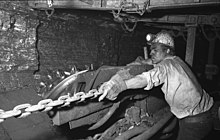
Back Qastarbayter Azerbaijani Гастарбайтер Bulgarian Gastarbeiter Catalan Gastarbeiter Czech Gastarbeiter German Gastarbeiter Greek Gastlaboristoj Esperanto Gastarbeiter Spanish Gastarbeiter Finnish Gastarbeiter Croatian
You can help expand this article with text translated from the corresponding article in German. (September 2011) Click [show] for important translation instructions.
|
Gastarbeiter (German for 'guest worker'; pronounced [ˈɡastˌʔaʁbaɪtɐ] ; both singular and plural) are foreign or migrant workers, particularly those who had moved to West Germany between 1955 and 1973, seeking work as part of a formal guest worker program (Gastarbeiterprogramm). As a result, guestworkers are generally considered temporary migrants because their residency in the country of immigration is not yet determined to be permanent.[1]: 87 Other countries had similar programs: in the Netherlands and Belgium it was called the gastarbeider program; in Sweden, Denmark, Norway and Finland it was called arbetskraftsinvandring (workforce-immigration); and in East Germany such workers were called Vertragsarbeiter. The term that was used during the Nazi era was Fremdarbeiter (German for 'foreign worker').[2] However, the latter term had negative connotations, and was no longer used after World War II.
The term is widely used in Russia (Russian: гастарбайтер, gastarbayter) to refer to foreign workers from post-USSR or third-world countries.[3][4]
- ^ Surak, Kristin (2013). "Guestworkers: A Taxonomy". New Left Review (84): 84–102. Retrieved 22 May 2022.
- ^ "Forced Labor – Terms". www.zwangsarbeit-archiv.de. 10 October 2011. Retrieved 21 October 2021.
- ^ Felperin, Leslie (1 July 2010). "Gastarbeiter". Variety. Retrieved 10 May 2020.
- ^ "Beyond the gastarbeiter: the other side of post-Soviet migration". openDemocracy. 18 September 2012.
© MMXXIII Rich X Search. We shall prevail. All rights reserved. Rich X Search




